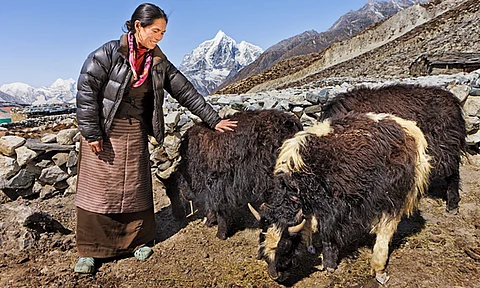

The yak, a ubiquitous presence in Nepal and the rest of the Hindu Kush Himalaya (HKH), must be elevated to its rightful place in the sustainable development agenda, Kathmandu-based International Centre for Integrated Mountain Development (ICIMOD) said in a statement on Nepal’s first ‘National Yak Day’.
ICIMOD Director General Pema Gyamtsho praised Nepal, which is now the first yak range country in the HKH to observe a national day dedicated to the animal.
“This is a proud and timely recognition of the immense cultural, ecological, and economic value of yaks in our mountain regions,” noted Gyamtsho in the statement released on April 20,2025.
He also called on policymakers, researchers, development partners, and mountain advocates to celebrate, support, and sustain yak herding in the HKH. “Let us listen to the voices of herders, invest in their knowledge, restore their rangelands, and ensure that future generations continue to witness the majestic silhouette of a yak on a mountain ridge. ICIMOD stands committed to supporting our partner countries in promoting sustainable, climate-resilient agropastoralism in the high mountains of the HKH.”
It is time to elevate the yak — a symbol of resilience, heritage, and harmony with nature — to its rightful place on the sustainable development agenda, the statement added.
Yaks are a lifeline in Nepal, divided between mountain and terai regions. According to ICIMOD, 27 mountain districts of the country depend on the animal for meat, milk, fibre, manure for fertiliser and draught power for agricultural tasks such as ploughing, in some of the world’s most challenging terrains.
Yaks are often crossed with domestic cattle in Nepal and across the Himalayas and Tibet to create the dzo or chauri gai. “These hybrids have enabled access to wider resource areas across altitudinal gradients, helping agropastoralists adapt to their mountain environments,” the statement noted.
Moreover, yaks are a keystone of cultural identity and socio-economic resilience in high mountain communities in Nepal. The Sherpa, Tamang, Thakali, Rai and Limbu indigenous communities of the Nepalese Himalayas have nurtured and protected yak herding traditions for generations.
“These communities are the backbone of mountain agropastoralism — which combines growing crops with raising livestock — their lives deeply intertwined with the rhythms of transhumance, the seasonal movement of livestock across mountain pastures. This unique system, recently inscribed by UNESCO as Intangible Cultural Heritage, is not only vital for food and livelihood security, but also for the sustainable management of fragile alpine ecosystems,” wrote Gyamtsho.